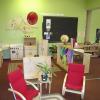- Identify the six elements of an effective schedule for preschool children.
- Describe and design strategies to help children be successful in routines.
- Identify parts of the day that may be most challenging for you and your preschoolers.
- Develop a schedule that works for your classroom.
Learn
Know
Preschool children are sensitive to their settings, and their behaviors and interactions with other children and adults are often different in different situations (Vitiello, Booren, Downer, & Williford, 2012). This means that preschool-age children are likely to have unique learning experiences when involved in various types of activities. To help preschool children develop the diverse skills they need to succeed, they should be exposed to different settings and activities throughout the school day. Providing a daily schedule will “allow for long, focused investigation periods and clear routines that children can count on for communicating with peers in whole-group experiences, some in which all will gather to discuss topics and processes related to the emergent inquiry,” (Broderick & Hong, 2020, p. 11).
Creating an effective schedule is like putting together a puzzle or a favorite recipe. There are certain “ingredients,” or elements that go into an effective schedule. The order and style of those elements are up to you. This lesson will introduce you to the six elements of an effective schedule. Then you will have a chance to consider how best to arrange these pieces for your classroom. The schedule is the big picture of the main activities you and the children engage in daily. Routines, on the other hand, are the steps done along the way to complete the schedule. Routines help provide a pattern and predictability to one’s day. Both elements help to promote autonomy and self-regulation in children. This lesson will also address how to create and support your classroom routines.
Elements of an Effective Schedule
There are six elements of an effective schedule. They are
- Free-Choice Time
- Outdoor Time
- Large Group Activities
- Small Group Activities
- Transitions
- Routines
1. Free-Choice Time
Children need many opportunities to engage in play and to follow their interests. An easy and effective way to provide these opportunities in the preschool classroom is to give children free-choice time. Free-choice time is time during the school day in which children make their own choices about what activities they engage in. Typically, this involves children choosing to play at one or more interest areas in the classroom (see Lesson One for more about interest areas). The teacher’s role during free-choice time is to make sure each child has the opportunity to pursue their interests and to make the most of these learning opportunities. This can involve monitoring the number of children at each interest area to ensure certain areas are not overwhelmed and making yourself available to children to support their activities. Children learn best during free-choice time when teachers actively scaffold their learning (Chien et al., 2010).
According to research that has looked at preschool children’s behavior in different settings and activities throughout the school day, children are more involved in activities that allow them independence and the opportunity to make choices. For example, Vitiello et al. (2012) found that children are more engaged with activities during free-choice time than they are during teacher-structured activities. This can likely be explained by the fact that children are more likely to remain interested and to keep working at an activity when they chose the activity in the first place, rather than the teacher choosing the activity for them. In free-choice time, preschoolers were also more engaged with their peers (Vitiello et al., 2012). Research tells us children who are more engaged in activities with their peers early on do better in school when they are older.
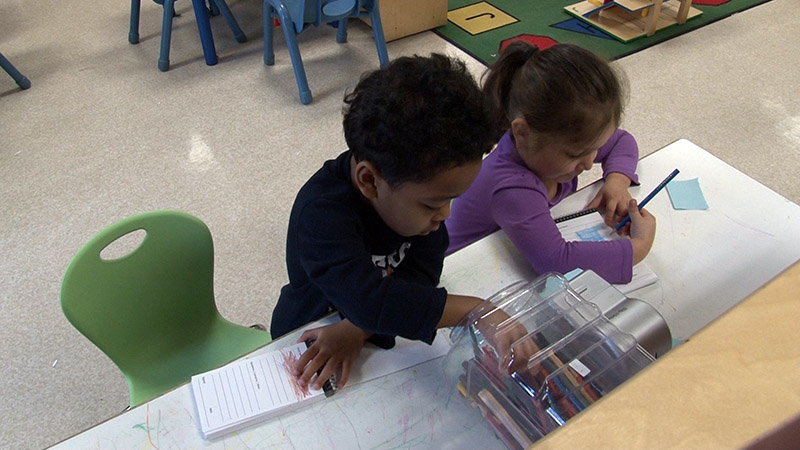
A substantial portion of the day should be dedicated to free-choice time in the classroom because this time is especially important for preschoolers. In most programs that operate eight hours or more, this means at least 60 minutes (Cryer, Harms, & Riley, 20012) should be dedicated to free-choice activities. This amount of time is critical for preschool-age children to engage in lengthy play ideas. The goal is active engagement. The materials you provide and your supportive interactions with children can help them become and stay engaged and can help children reach learning goals.
2. Outdoor Time
Like indoor free-choice time, outdoor time is also an important part of the preschool day. Outdoor time is similar to free-choice time as it often allows children to direct their own play and learning and to follow their interests. In addition, preschool children are highly engaged with activities and in play with other children during outdoor time (Vitiello et al., 2012). However, unlike free-choice time in the classroom, outdoor time allows for greater opportunities to strengthen large muscles and interactions with the natural world. Research shows children who spend more time outdoors are more physically active and, therefore, less likely to suffer from health problems in the future (Hinkley, Crawford, Salmon, Okely, & Hesketh, 2008).

At least 60 minutes per day should be spent outdoors, weather permitting, for programs that operate eight hours or more (Cryer, Harms, & Riley, 20012). In full-day programs, this amount of time should be spent outdoors in both the morning and the afternoon. Outdoor time can take different forms. In some preschools, children may have access to an outdoor fixed playground area in which they can choose where and how to play. Children often are most physically active when they play with portable equipment such as balls and bicycles, regardless of whether or not they have access to fixed playgroup equipment. Teachers can provide these types of equipment, as well as other traditional outdoor toys like chalk and bubbles and create outdoor interest areas for children to choose from.
Many of the same materials you provide indoors can be used to promote engagement outdoors as well. In addition to traditional outdoor toys like bikes, balls, and chalk, consider providing dramatic play props, sand and water tables, pencils and paper, a basket of books in the shade, and blocks or natural materials for building. Also consider bringing the class pet (like a rabbit) outdoors if appropriate. Doing these things will help children stay actively engaged and provide opportunities to extend their learning.
3. Large-Group Activities
Preschool children also benefit from large-group activities that are initiated by a teacher. These activities involve instruction or discussion focused on building children’s inquiry, academic, and social skills. Many interesting things can happen during large-group time. This time provides an opportunity to read stories to the group, sing songs, discuss the daily schedule or calendar, encourage children to share special events or items, welcome a guest visitor or new child, and build classroom community.
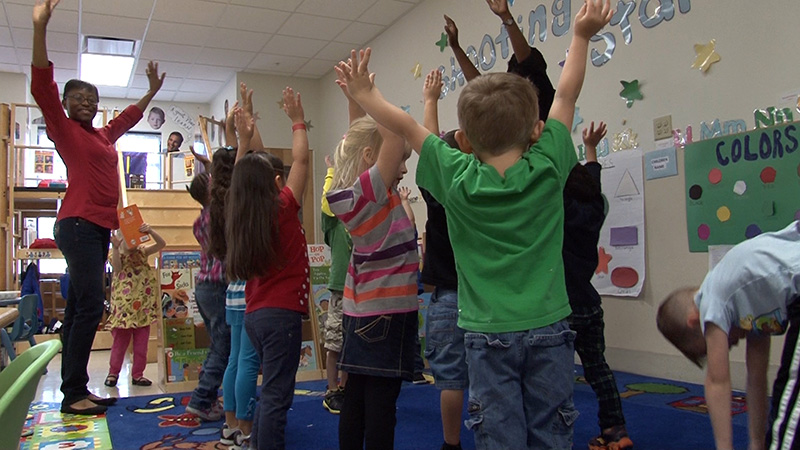
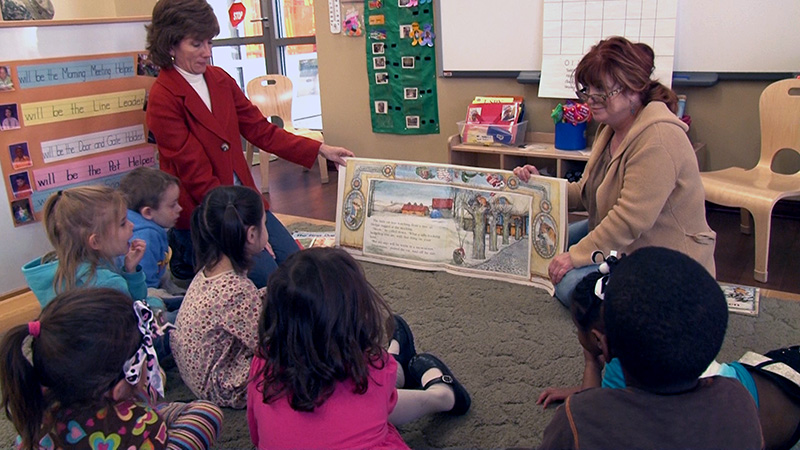
Research shows that teacher-guided, large-group time may be especially important for helping preschoolers develop early literacy skills. Large-group time can also help children strengthen their skills in paying attention and learning to control their behaviors. It is important to remember that teacher-directed large-group times should be kept short. Young children learn best if group times are 15 to 20 minutes or less (Hemmeter, Ostrosky, Artman, & Kinder, 2008).
4. Small-Group Activities
Small-group activities offer a chance to focus on important learning goals in a personal setting. These types of activities are ideal for promoting children’s active engagement. Wait time is reduced because fewer children are involved, and children get to spend more time actively manipulating materials. Small-group activities also allow children to interact with their peers combined with one-on-one attention from the teacher. This time provides opportunities for teachers to observe and document the ways children interact with the materials and can help determine a focus for inquiry.
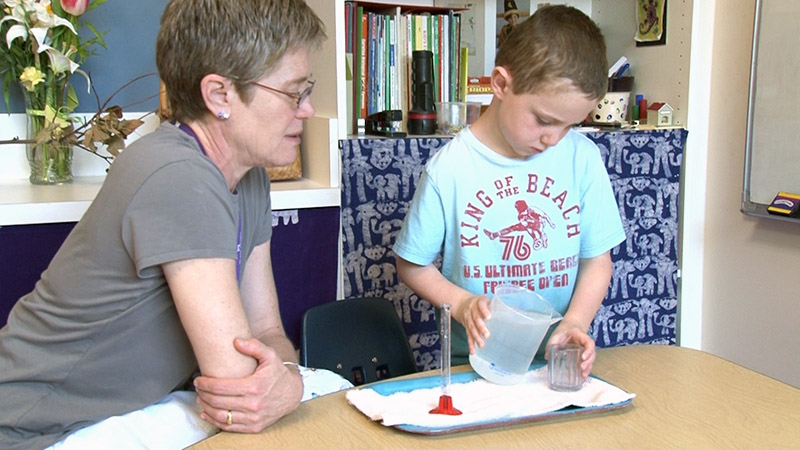
There are many ways teachers can use small-group activities to promote engagement and learning. Teachers may read a story during small groups, offer a science experiment, work on an art project, play a board game with children, or do any other activity that requires extra adult attention. Similar to large-group activities, small-group time should be kept to 15 minutes or less per group. Small groups are a perfect option to have available during center or free-choice time.
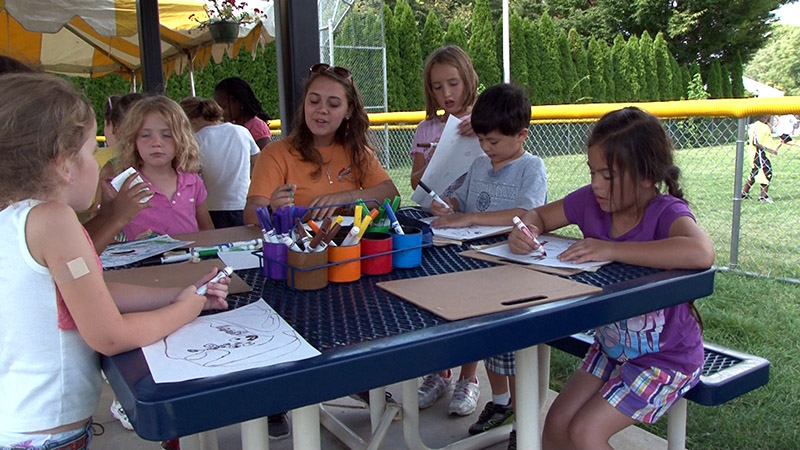
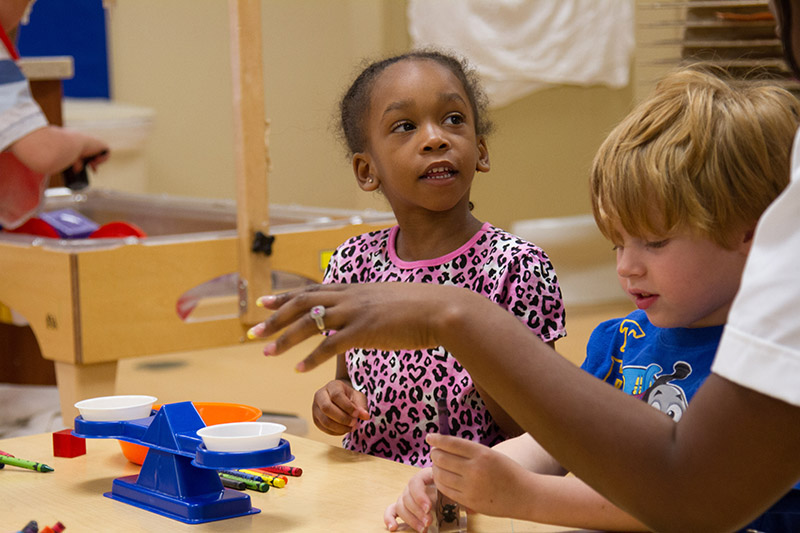
5. Transitions
Transitions are unavoidable in preschool classrooms. There are times during the day when children must stop one activity and start another, for example, cleaning up interest areas and lining up to go outside. Transitions are often a difficult part of the preschool day, and child engagement can be low during this time. Even though some transitions are necessary, teachers can do their best to minimize transitions and keep children engaged. Both preventive and individualized strategies can help create smooth transitions.
To minimize transitions, consider all of the activities in your day that require all children to do the same thing at the same time. First, ask yourself: Are all of these transition times necessary? For example, the importance of small-group time was mentioned above. However, this does not mean that small-group time needs to be a separate block of time in the preschool day. Instead, you could make children’s free-choice time longer and include small-group activities as choices within the free-choice time period. That would allow you to eliminate the transition between free-choice time and small-group time.
Next, ask yourself: Do all of the children need to do the same thing at the same time during transitions? For example, consider the transition between large-group time and snack time. Instead of sending all the children to wash their hands at the same time, perhaps you can send a few children at a time to wash their hands while you keep the rest of the children engaged with songs or discussions. Then, when a child returns from washing hands, you can indicate that it is the next child’s turn.
You can also consider whether some children can transition on their own. For snack time, you could decrease the number of whole-group transitions by offering “open snack.” Here, teachers simply prepare the snack table and offer it as a choice where children come and go from this space as they are ready. Sometimes, an adult sits at the table to assist. In other classrooms, independence is promoted by laying out placemats or picture cards to indicate how much food to take and what to do when you are finished. In addition, some teachers create a checklist on which children can mark whether they ate snack; this can help teachers track which children may need reminders to try snack before that option is closed. Open snack can not only decrease transitions but can help teach children to be aware of the signs of hunger or thirst within their own bodies and gives them greater control over meeting those needs.
There are also other ways to keep children positively engaged during transitions. Like adults, children appreciate knowing ahead of time when a change is coming. Before the end of an activity, it may be helpful to give children a “5-minute warning” when there are 5 minutes left before it is time to clean up. You can use child-friendly tools like a timer to help children know when the transition will occur. Singing songs with accompanying movements (e.g., hand clapping) during transitions such as clean up or handwashing may help keep children focused on what they are doing and prevent long waiting times in which children have nothing to do. Finally, make sure to have materials such as books, puzzles, and puppets available for children who are waiting to begin the next activity.
6. Routines
Routines are an important part of the classroom day. Routines in preschool classrooms include things such as arrival time, bathroom time, clean-up time, naptime, and departure time. Many routines, such as meals or group time, are necessary and helpful to building a consistent classroom community. Planning is the key to successful routines and the routines should match the children’s stage of development. For preschool children, this means that routines should support children’s developing abilities to do things on their own but should not be too complicated for preschoolers to learn and remember.
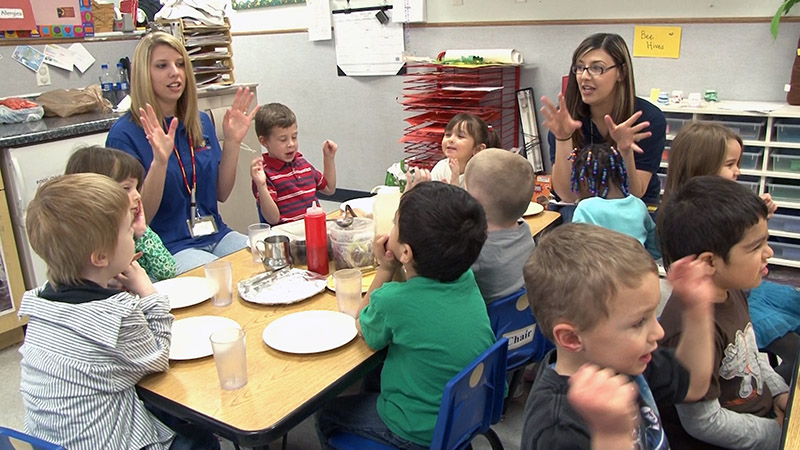
Some children engage in these routines with no problems. Other children have a harder time. There are things you can do to help all children make the most of these daily routines. First, you need to think carefully about what you want children to do. Think of a routine like morning arrival. What do you want children to do when they enter the room? Be specific and consider using a predictable sequence instead: Sign in, put coat in cubby, wash hands, and find a quiet activity in an open interest area. See how these details could help all children be more successful?
It is often helpful to plan your routines as if you need to explain them to a new teacher or child. What details would that individual need to know? If children are struggling with a particular routine, it can be helpful to observe where the routine breaks down. Think about a routine that your class struggles with. Maybe children in your class have a hard time during drop-off. Spend some time watching the children as they arrive.
- Do they complete any of the steps?
- What directions do you find yourself repeating over and over?
If you watch the children and notice that they often stop to look at toys or greet friends before they put their coats away, this gives you important information. This probably means your room is set up in a way that creates distraction in the morning routine. Perhaps cubbies are too far away from the door. Perhaps the walkway to the cubbies goes straight through interest areas where children congregate. Think about designing your room in such a way that it guides children into successful routines. There is a clear path from the door to the sign-in sheet, then to the cubbies, then to the sinks, and finally the room opens up.
Think the same way about other routines.
- Are snack spaces situated near the sinks and kitchen supplies?
- Are extra clothes near the restroom?
- Are garbage cans located conveniently around the room?
All of these factors can help ease transitions and minimize distractions.
The best routines have a clear beginning and end. For example, for a mealtime routine, children will know “I wash my hands, sit at the table, sing a rhyme with the class, eat my food, clean up, and brush my teeth.” Do not forget that adults need to teach children these routines directly. Also, remember you can use songs or visual supports to help routines. Examples include color-coded feet on the floor so children know where to stand when lining up to go outside or a series of pictures and words to remind children the proper steps in handwashing.
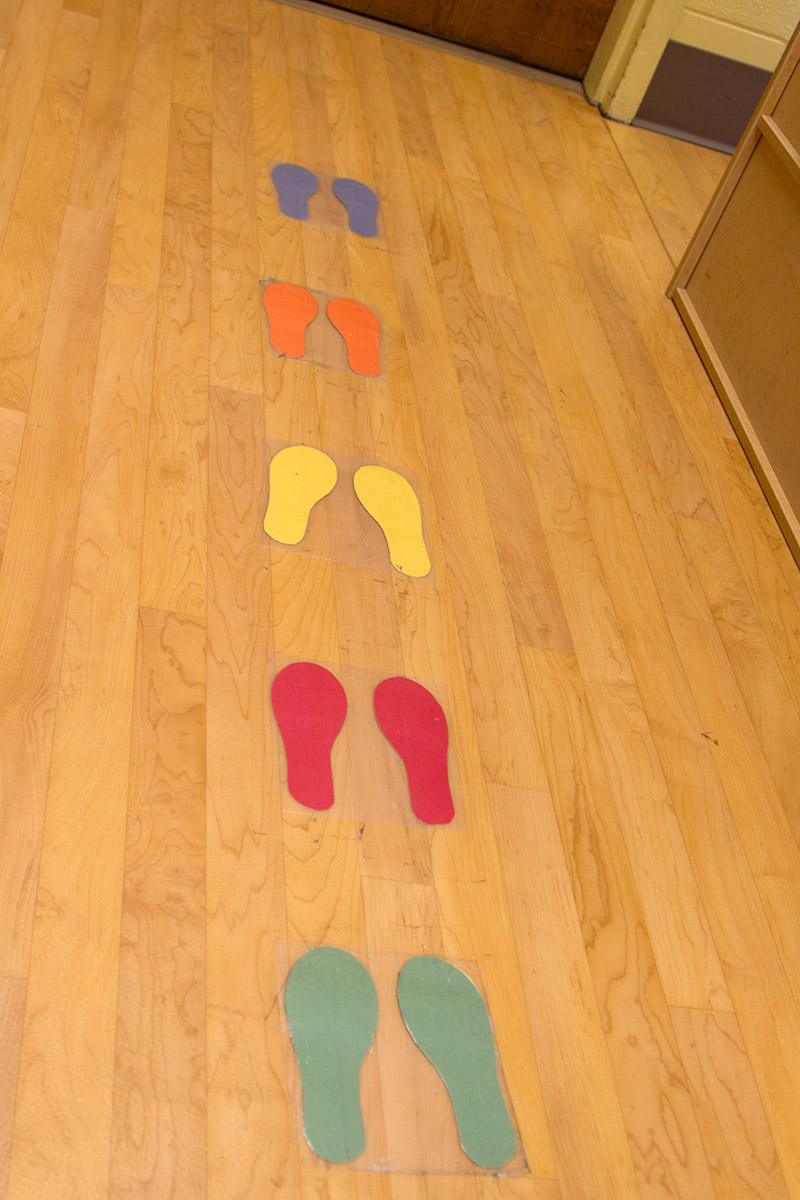
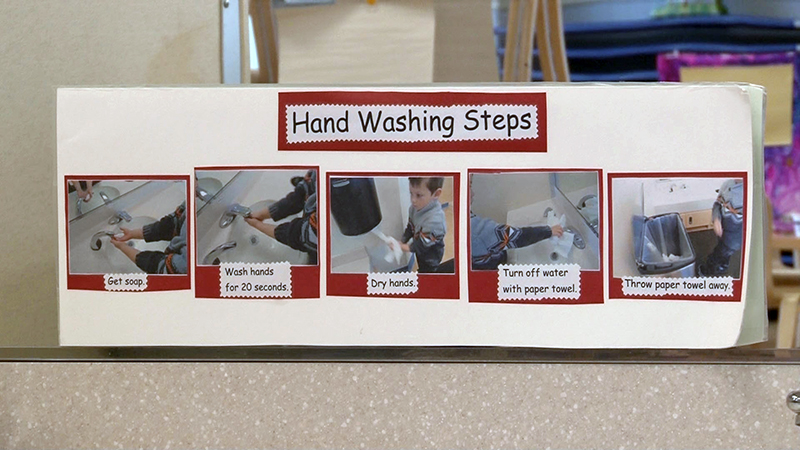
Communicate Your Schedule
Once you have designed an effective schedule, it is important to communicate this schedule to the children and other adults. You can eliminate many problems simply by helping children understand the schedules and routines in the classroom. The best way to do this in a preschool classroom is through a visual schedule. Visual schedules use pictures or objects to represent times of the day. Often these pictures are combined with words to help encourage preliteracy skills.
Visual schedules work best when they are part of your daily routine. They are helpful as reminders for all children, but especially useful when a new child is going to transition into the classroom or when a personal event may make a child cling to something familiar. Here are ideas to make a schedule work for you:
- Make it a part of your daily routine. Mention it at the beginning and end of each large-group activity.
- Make it fun. As you finish an activity, let children remove that schedule piece, turn it over or put a checkmark on it with erasable marker.
- Give children choices. Let the class vote on how to arrange your schedule together as a group each morning. For example, ask them whether story time should come before or after snack.
- Provide a job chart. This enables children to feel they have an active role in the classroom, and it allows them to actively demonstrate responsibility.
- Individualize it. Consider making individual picture schedules for children who are struggling. You could make a circle-time schedule, a center (or interest area) time schedule, or a full daily schedule for a child who needs extra reminders about where to go and when.
- Remember to create a schedule to share with adult coworkers and families, too. This can be typed and posted on a bulletin board or sent home to families. Consider their feedback. Everyone feels better when they know what to expect each day.
See
How you organize your time is just as important as how you organize the space in your classroom! It is essential to provide a schedule that is structured yet flexible enough to meet children’s needs. Watch this video to learn about the six components of an effective schedule for preschool children: free-choice time, outdoor time, large-group time, small-group time, transitions, and routines.
A Day in Preschool
Now consider how to communicate your schedule to children. Watch this video for ideas about how to help children succeed in activities and routines.
Communicating Your Schedule
Finally, consider how visual supports can help children be successful in routines. Visual supports help the environment serve as another teacher and they are easy to create and use. The following video provides examples of two kinds of visual supports for young children: task analyses (step-by-step pictures on how to participate in routines, e.g., pictures showing how to put on a coat) and environmental supports (clues about how to move or behave while participating in the routine, e.g., marks on the floor showing where to sit or stand).
Visual Supports for Your Routines
Do
Design an Effective Schedule
All of these elements will help you create an effective, developmentally appropriate schedule. Within your schedule, you have freedom to design activities, interactions, and materials that meet the individual needs of children in your class. Here are tips to help you make the most of your day:
- Provide at least 60 minutes of free-choice time each day. Move around to support learning goals while children engage in interest areas.
- Provide at least 60 minutes of outdoor time each day. Provide many of the same indoor interest areas outdoors.
- Keep large- and small-group times short. A total of 15-20 minutes is best.
- Keep children engaged during transitions. Problem behaviors are most likely to occur during wait time.
- Provide warnings before transitions. Although children may be used to the sequence of routines in your classroom, many young children may find it challenging to switch immediately to a new activity, especially if they really enjoy what they are currently working on. Giving auditory or visual cues you are about to transition to another part of the day (e.g., “clean-up time is in 5 minutes”) can make these transition times easier.
- Use visual supports to help children know what to do and to stay engaged. For example, attaching color-coded feet on the floor can give children a place to stand and be an instant color-matching activity.
- Incorporate movement and music into daily routines and transitions: fly like a bee to the door, gallop like a horse, copy a clapping pattern, or sing a silly clean-up song.
- If a child struggles with transitions, give the child an important job such as helping set the table, inspecting the interest areas to make sure they are clean, or giving transition warnings to classmates.
- Be structured in your classroom routines. Predictable routines help children know what to expect and to feel secure. The security children feel by knowing what to expect allows them to fully engage in play and learning in the classroom.
- Be flexible in your classroom routines. Both structure and flexibility are important. If a routine is not working, rethink it! Be comfortable with making the most of unexpected events. Flexibility still implies that you are following a plan; you can simply stretch or shorten the amount of time you spend on each activity. If there will be a change in the daily schedule for some reason (e.g., a special visitor that day), make sure children are aware of the change, and include visual cues about schedule changes whenever possible.
- Make sure the physical environment supports your routines. For example, move personal storage or morning check-in as needed to support arrival routines.
- Teach all children the skills to navigate routines by using the following strategies:
- Modeling: Demonstrate steps in the routine to the child while explaining aloud what you are doing (e.g., handwashing).
- Using Peer Partners: Ask a child who knows a routine well to demonstrate the routine to the child who is struggling.
- Using Prompts: Although you have visual supports for routines in your classroom, some children may benefit from verbal reminders regarding specific steps (e.g., for handwashing: “OK, you have turned off the water. What is the next step?”)
- Giving Encouragement: Provide specific, positive feedback when the child navigates a routine successfully (e.g., “I saw that when you came to school today you went straight to your cubby and put your things away”).
Explore
In this lesson, you learned how to organize your time with preschoolers. You might have noticed that a lot of time is spent in transitions. The Using Transition Time activity will help you learn more about engaging children during transitions. Watch the video and answer the questions. Share your responses with your trainer, coach, or administrator and compare your answers to the suggested responses.
Apply
Take some time to think about your own classroom schedule and how well each day flows. Do you experience challenges with particular parts of the day? Which parts run smoothly, and which are more problematic? Consider what makes some parts of the day especially difficult. What do those daily “trouble spots” have in common? Use the Day Planner activity to help you problem-solve difficult parts of your own day. Talk to a trainer, coach, or administrator about your responses.
Take time to consider how your schedules and routines work for all the children in your room and how you might better support children with special needs. Use the References & Resources list from this lesson to find additional information on supporting all learners with schedules and routines.
Glossary
Demonstrate
Broderick, J. T, & Hong, S. B. (2020). From children’s interests to children’s thinking: Using a cycle of inquiry to plan curriculum. National Association for the Education of Young Children.
Butler, A. M. & Ostrosky, M. M., (2018). Reducing challenging behaviors during transition: Strategies for early childhood educators to share with parents. Young Children, 73(4). https://www.naeyc.org/resources/pubs/yc/sep2018/reducing-challenging-behaviors-during-transitions
Cabell, S. Q., DeCoster, J., LoCasale-Crouch, J., Hamre, B. K., & Pianta, R. C. (2013). Variation in the effectiveness of instructional interactions across preschool classroom settings and learning activities. Early Childhood Research Quarterly, 28(4), 820-830.
Cryer, D., Harms, T., & Riley, C. (2012). All about the ECERS-R: A detailed guide in words and pictures to be used with ECERS-R. Kaplan Early Learning Co.
Dickinson, D. K., & Porche, M. V. (2011). Relation between language experiences in preschool classrooms and children’s kindergarten and fourth-grade language and reading abilities. Child Development,82(3), 870-886.
Dodge, D. T., Heroman, C., Berke, K., Bickart, T., Colker, L., Jones, C., Copley, J., & Dighe, J. (2016). The creative curriculum for preschool (6th ed.). Teaching Strategies, Inc.
Fox, L., & Lentini, R. H. (2006). “You got it!” Teaching social and emotional skills. Young Children, 61, 36-42. https://challengingbehavior.cbcs.usf.edu/docs/YouGotIt_Teaching-Social-Emotional-Skills.pdf
Grisham-Brown, J., Hemmeter, M. L., & Pretti-Frontczak, K. (2005). Blended practices for teaching young children in inclusive settings. Brookes Publishing Co.
Hemmeter, M. L., Ostrosky, M., Artman, K., & Kinder, K. (2008). Moving right along: Planning transitions to prevent challenging behavior. Young Children, 63, 18-25. https://www.mbaea.org/media/documents/Young_Children__May_2008_Transition_06611DCA084CF.pdf
Hinkley, T., Crawford, D., Salmon, J., Okely, A. D., & Hesketh, K. (2008). Preschool children and physical activity: A review of correlates. American Journal of Preventive Medicine, 34(5), 435-441.
Kreichauf, S., Wildgruber, A., Krombholz, H., Gibson, E. L., Vögele, C., Nixon, C. A., Douthwaite, W., Moore, H. J., Manios, Y., Summerbell, C. D. (2012). Critical narrative review to identify educational strategies promoting physical activity. Obesity Reviews, 13, 96-105.
Lentini, R., Vaughn, B. J., & Fox, L. (2009). Routine-based support guide for young children with challenging behavior. University of South Florida, Early Intervention Positive Behavior Support. https://www.ecmhc.org/TTYC/documents/Folder1TipsForms/File%20G%20Routine%20Based%20Support%20Guide/Routine%20Based%20Support%20Guide%20Rev1209.pdf
Milbourne, S., & Campbell, P. (2007). CARA’s Kit: Creating adaptations for routines and activities. https://www.naeyc.org/search/cara%27s%20kit
Ostrosky, M. M., Jung, E. Y., Hemmeter, M. L., & Thomas, D. (2007). Helping children understand routines and classroom schedules. Center on the Social and Emotional Foundations for Early Learning. http://csefel.vanderbilt.edu/kits/wwbtk3.pdf
Sandall, S.R., & I. S. Schwartz. (2008). Building blocks for teaching preschoolers with special needs. (2nd ed.). Brookes Publishing Co.
Vitiello, V. E., Booren, L. M., Downer, J. T., & Williford, A. P. (2012). Variation in children’s classroom engagement throughout a day in preschool: Relations to classroom and child factors. Early Childhood Research Quarterly, 27, 210-220.


